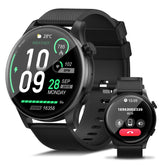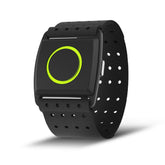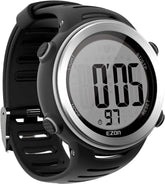Climbing Edge: Heartbeat Monitors and Route - Specific Training
Climbing is a unique blend of strength, technique, and endurance—where success depends on matching your effort to a route’s difficulty. A heartbeat monitor turns vague fatigue signals into actionable data, helping you tailor training for steep boulders, overhangs, or long multi-pitch routes. This guide explains how to use EZON’s C009Pro, C022Pro, and R7 to optimize strength, manage exertion, and recover smarter—whether tackling a 5.8 beginner route or a 5.12 advanced challenge.
1. Why Heart Rate Matters in Climbing
A. The Physiology of Climbing Effort
-
Intermittent Intensity: Climbing alternates between explosive efforts (dynos, grip holds) and static endurance (sustained positions), making heart rate a critical gauge of anaerobic vs. aerobic balance.
-
Route Difficulty & Heart Rate Correlation:
- Beginner Routes (5.5–5.8): Steady, low-intensity effort (60–70% MHR) focuses on technique over brute strength.
- Intermediate Routes (5.9–5.11): Mix of sustained holds and short bursts (70–80% MHR) demands endurance + power.
- Advanced Routes (5.12+): High-intensity, anaerobic efforts (80–90% MHR) with rapid recovery between cruxes.
MHR = 220 - age (e.g., a 25-year-old climber has a 195 BPM max)
2. Route-Specific Training with Heart Rate Data
A. Beginner Routes: Build Technique & Aerobic Endurance
- Goal: Keep heart rate in Zone 2 (60–70% MHR) to focus on footwork and grip efficiency.
-
Training Drill:
- 3x 10-minute climbs on 5.8 routes, resting 5 minutes between attempts. Use the EZON C022Pro armband to track:
- Average HR (aim for 117–136 BPM for a 25-year-old).
- Recovery time (HR should drop to <60% MHR within 3 minutes of resting).
- 3x 10-minute climbs on 5.8 routes, resting 5 minutes between attempts. Use the EZON C022Pro armband to track:
- Why It Works: Low-intensity efforts build capillary density in forearms, reducing early fatigue on longer routes.
B. Intermediate Routes: Balance Power & Stamina
- Goal: Train to sustain 70–80% MHR during sustained holds, with brief spikes to 80–85% MHR for cruxes.
-
Training Drill:
- 4x 8-minute climbs on 5.10 routes, incorporating 2x 30-second "power moves" (e.g., dynos). Use the EZON C009Pro chest strap for:
- Real-time alerts if HR exceeds 80% MHR during sustained sections (signals over-gripping).
- Post-climb analysis of effort distribution (e.g., 60% Zone 3, 40% Zone 4).
- 4x 8-minute climbs on 5.10 routes, incorporating 2x 30-second "power moves" (e.g., dynos). Use the EZON C009Pro chest strap for:
- Pro Tip: Pair with the EZON R7 smartwatch to log route details (angle, hold type) alongside HR data—identify patterns (e.g., overhangs spike HR faster).
C. Advanced Routes: Master Anaerobic Capacity
- Goal: Tolerate 80–90% MHR during cruxes, with rapid recovery (HR drops 20 BPM in 1 minute) to tackle subsequent sections.
-
Training Drill:
- 5x 5-minute climbs on 5.12 routes, resting 2 minutes between attempts. Use the R7 to track:
- Max HR during cruxes (aim for 85–90% MHR, not 100%—avoids burnout).
- HRV (heart rate variability) pre-climb—low HRV means skip intense efforts to prevent injury.
- 5x 5-minute climbs on 5.12 routes, resting 2 minutes between attempts. Use the R7 to track:
3. Strength-Building Exercises: Guided by Heart Rate
A. Climbing-Specific Strength Workouts
-
Finger & Forearm Strength:
- Hangboard sessions: 4x 30-second hangs (open/closed grip) with 2-minute rests. Use C022Pro to ensure HR stays <70% MHR—higher rates indicate inefficient gripping.
-
Core & Leg Power:
- Weighted step-ups + pull-ups: 3x 10 reps/side. C009Pro alerts if HR exceeds 75% MHR—signals poor form (e.g., swinging on pull-ups).
4. Recovery Techniques: Let Heart Rate Guide Rest
A. Post-Climb Recovery Protocols
-
Active Recovery:
- 15-minute easy walk or yoga (Zone 1, 50–60% MHR) to flush lactic acid from forearms. Use R7 to track HR recovery rate—faster drops mean better conditioning.
-
Rest Day Monitoring:
- Check resting HR (RHR) with R7 daily. A 5+ BPM increase from baseline means extend rest—critical for preventing overuse injuries (e.g., pulley strains).
-
Nutrition Timing:
- Consume 20g protein + 30g carbs when HR returns to <65% MHR post-climb—optimizes muscle repair.
5. EZON Gear: Built for Climbing’s Demands
A. C022Pro Armband: Freedom of Movement
- Advantages: Adjustable elastic strap stays secure during wide reaches; 3ATM waterproofing handles sweat/rain (outdoor crags).
- Best For: Beginner/intermediate climbers prioritizing comfort during technique drills.
B. C009Pro Chest Strap: Precision in High Intensity
- Advantages: ±1 BPM accuracy during dynos/jumps; 365-hour battery lasts months of training.
- Best For: Advanced climbers needing reliable data during anaerobic efforts.
C. R7 Smartwatch: Route Logging + HR Sync
- Advantages: GPS marks crag locations; 4-channel PPG sensor tracks HR during both climbing and rest.
- Key Feature: Logs "route difficulty vs. HR" trends—e.g., 5.11 routes average 145 BPM for you, guiding future goal-setting.
6. FAQs: Climbing with Heart Rate Monitors
Q: Can wrist-based monitors work for climbing?
- The R7’s wrist sensor works for steady efforts but may undercount during dynamic moves. Pair with C009Pro/C022Pro for accuracy.
Q: How to avoid HR monitor interference on overhangs?
- C022Pro’s armband stays clear of rock walls; C009Pro’s chest strap is protected by harnesses—both avoid friction issues.
Q: When to ignore high HR during climbs?
- Brief spikes (>90% MHR) during 10-second cruxes are normal—focus on recovery speed, not the spike itself.
Climb Stronger, Smarter: Data-Driven Progress
Climbing’s greatest challenge isn’t just the route—it’s knowing when to push and when to hold back. With heartbeat monitors like EZON’s C009Pro, C022Pro, and R7, you’ll turn effort into strategy, matching your heart rate to the route’s demands and inching closer to that next send.
Ready to scale new heights? Let your heart rate guide the way.









